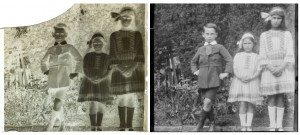Photo Restoration
glass plate negatives
We have been busy restoring some glass negatives from the 1900’s and some stereoscopic images from the 60’s.. See the photo restoration page for more information on our services
Here is a link to the collection from the History Trust of South Australia and their glass negative collection which highlights an image of the month.
http://www.history.sa.gov.au/chu/programs/glass_negs/info_images.htm
There are two basic types of glass plate negatives – Collodion Wet Plate and Gelatine Dry Plate.
- Collodion Wet Plate Negatives were in use from 1851 until the 1880s. They were invented by Frederick Scoff Archer. They used a viscous solution of collodion, coated glass with light-sensitive silver salts. Being glass and not paper, wet glass plates created a sharper, more detailed negative. A Collodion wet plate negative can usually be identified by an unevenly coated emulsion, thick glass, rough edges.
- Silver Gelatine Dry Plate Negatives were invented by Dr. Richard L. Maddox in 1873. Unlike the wet plate variety gelatine , needed less exposure to light than the wet plates. Other distinguishing features between the wet and dry variety were the thinner glass and a more evenly coated emulsion. Dry plate glass negatives were in common use between the 1880s and the late 1920s.

